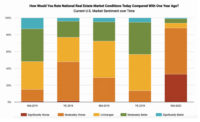But in the past two months, the markets have significantly slowed down, and have reached about half of the $35 billion forecast. “Thirty-five billion dollars was a comfortable number, I don’t think anyone has an idea whether we will get to 35 or not,” Renna says.
“Much of the positive momentum that had been surrounding the CMBS market recently has now all but vanished in the past few weeks,” states a July report by Trepp LLC, a New York-based firm that analyzes CMBS.
New Focus on Tenant Risk
In June, S&P rolled out a new index for the CMBS market that identified tenant risk. The new index created a pause in the market because it took a dim view of retail tenants, especially those that are local and privately held. And in a preview of its later downgrading of U.S. credit, the rating agency even said in a report that leases with federal agencies are not as strong as they once were.
“With upcoming federal spending cuts likely as a consequence of increasing calls to balance the budget, the U.S. Government, which in our opinion has extraordinary bargaining power, may not continue to pay above-market rents for these properties, especially at renewal or early lease termination dates. This introduces some extra refinancing risk, especially for leases that contain early termination options within a few years of the loans maturity dates,” S&P said in the June report.
Then, in July, S&P induced more uncertainty with its decision not to rate the a $1.5 billion commercial-mortgage bond that had already been placed and priced.
The S&P action introduced “an entirely new level of risk to the new issue of CMBS market,” according to Trepp ‘s July report. “With the commercial real estate market already worried about how borrowers were going to find enough financing to handle the wave of loan maturities hitting the market over the next few years, this only added to current concerns.”
Non-functioning Securitization
The result is uncertainty and less money available for commercial markets.
“If the securitization market isn’t functioning in a healthy way, the market can only make so many loans and it limits the amount the originating lender can lend,” Renna says.
Julia Tcherkassova, a mortgage-debt analyst at Barclays Capital Inc., struck a similar chord. She told interviewers on Bloomberg TV that when a CMBS dealer is putting a deal out, "it is important to know what the execution levels will be. When there has been pricing of a new deal and they don’t close, it is increasing problems for the others ."
While the slowdown in CMBS is nothing like the meteorite that hit the general buildings market in 2008's bank and financial market turmoil, building owners with deeper pockets and unusual financing schemes will be among the small number able to build.
That's especially true in a hard-hit market like Las Vegas, where new hotel construction is dead.
In one arrangement, Stable Development is building medical offices in Henderson, Nevada, with long leases by physicians and medical practice groups. Stable broke ground June 9 on a new $25-million, 115,000-sq-ft office complex.
Under the leases, tenants share in the distribution of net cash flow, mortgage interest tax deduction and depreciation tax benefits. They also benefit from rental cash flow that can reduce the monthly cost of the offices.
Then there is the old-fashion approach of the developer funding a project with its own cash. That's the case at the Harmon Corner Shopping Center, in Las Vegas, where the $100-million project topped off recently.




Post a comment to this article
Report Abusive Comment